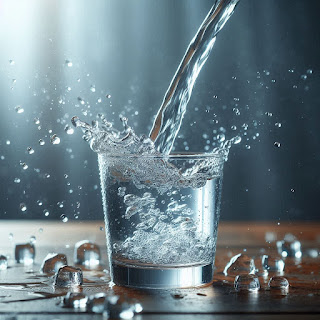Modelling water pouring from a glass into another container in Ansys Fluent involves simulating a multiphase flow. Here's a general approach:
* Create a 3D model of the glass, the receiving container, and any connecting elements (e.g., spout).
* Ensure a good mesh quality, especially around the pouring region where the water encounters air.
**2. Multiphase Flow Setup:**
* In Fluent, activate the "Multiphase" model under "Models" in the project tree.
* Select the "Volume Of Fluid (VOF)" method for capturing the water-air interface.
**3. Material Properties:**
* Define water and air as separate materials. Specify their properties like density and viscosity.
**4. Boundary Conditions:**
* Set the glass interior as a "Volume Fraction" with a value of 1 (pure water).
* Set the receiving container interior as a "Volume Fraction" with a value of 0 (pure air).
* Define an outflow boundary condition at the top of the receiving container for released air.
**5. Solver Settings:**
* Choose an appropriate pressure-velocity coupling scheme.
* Set up appropriate turbulence models (if applicable).
**6. Simulation and Results:**
* Initialize the volume fraction for water to be entirely within the glass.
* Run the simulation.
* Monitor the volume fraction contours to visualize the water flow and filling process.
**Additional Tips:**
* Start with a simpler geometry (e.g., cylindrical glass) for initial simulations.
* Consider using tutorials or examples available online for Ansys Fluent on multiphase VOF simulations [YouTube tutorial on container filling analysis with VOF in Ansys Fluent].
## Defining Domains and Boundary Conditions for Water Pouring in Ansys Fluent
Here's a more detailed explanation of defining domains and boundary conditions for your water pouring simulation:
**Domains:**
1. **Water:** Create a separate domain encompassing the entire volume of water inside the glass. This can be done by selecting the cells within the glass geometry and assigning them a new "Fluid" zone.
2. **Air:** Create another domain for the air. This will include the remaining volume outside the water in the glass, the receiving container (initially filled with air), and the surrounding environment. You can assign this entire region a separate "Air" zone.
**Boundary Conditions:**
1. **Inlet (Water):**
* Type: Set the top surface (or opening) of the glass as a "Volume Fraction."
* Values: Here's where you define the water's initial location.
* Set the "Volume Fraction" of water to "1" for all cells within this boundary. This signifies pure water entering the simulation.
2. **Outlet (Air):**
* Type: Define the top opening of the receiving container as a "Pressure Outlet" or "Outflow." This allows air to escape as the water fills the container.
* Values:
* For "Pressure Outlet," set the gauge pressure to "0 Pa" (atmospheric pressure).
* For "Outflow," set the "Backflow" option to "No" to prevent air re-entering the container.
3. **Walls:**
* Type: Set the walls of the glass, the receiving container, and any other solid boundaries as "Wall."
* Values:
* Select the "No Slip" option for the velocity to account for the no-flow condition at the walls.
* You can optionally define a specific wall roughness if desired.
4. **Interface:**
* Fluent automatically captures the water-air interface based on the VOF method. No specific boundary condition is needed for the interface itself.
**Additional Considerations:**
* **Symmetry:** If your geometry is symmetrical (e.g., cylindrical glass), you can model only half of the system and define a symmetry plane as a boundary condition to reduce computational cost.
* **Initial Conditions:** Besides setting the water volume fraction to 1 at the inlet, you might need to define initial conditions for other variables like velocity (set to zero for stagnant water initially).
**Resources:**
* Ansys Fluent Documentation: Refer to the official Ansys Fluent documentation for detailed explanations of boundary conditions and their settings.
* Tutorials: Utilize online tutorials for Ansys Fluent on VOF simulations to gain a visual understanding of the process [Example: YouTube tutorial on container filling analysis with VOF in Ansys Fluent].




No comments:
Post a Comment